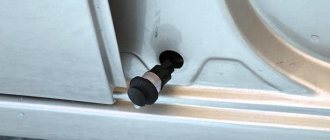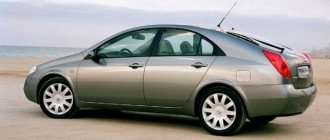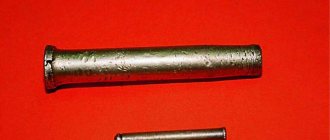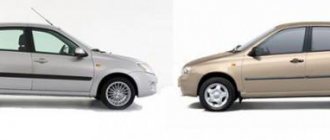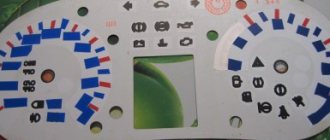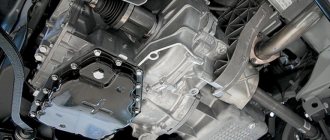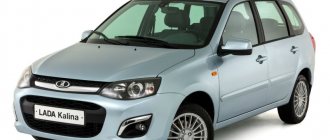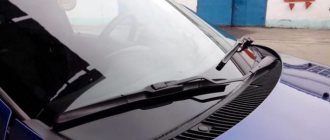Testing methodology
The car in question was destroyed in just one crash test. It was a frontal impact with a 40 percent overlap, and the car itself was accelerated to 64 km/h. Let us clarify once again - here we are talking about equipment 21942-42, equipped with pyrotechnic belt pretensioners. The wheels in this configuration are made of light alloy, which, in turn, could also affect the result.
Station wagon Kalina-2 Lux, photo from the official website
After gaining speed, the station wagon body encounters an obstacle that covers 40% of the space and is located on the driver’s side. This method of testing a car is close to the EuroNCAP methods used for a long time in Europe. What happened as a result is described in the next chapter. In fact, the Lada Kalina car received 3 stars out of 4 possible, which is not so bad. The Granta in the sedan body did not earn much more points, but it was tested using a similar method.
Crash test procedures
European cars are crashed according to the special EuroNCAP program, Japanese cars - according to JNCAP, in Australia - according to ANCAP. There is no own program for Russian cars. The emergency testing procedure is not the cheapest undertaking. In the case of the Lada Kalina, the crash test results conducted by the AvtoVAZ plant are not publicly available. Tests are carried out by independent and non-governmental organizations under the more loyal ARCAP program, since under the same European system a domestic car is unlikely to score good points.
This type of crash test involves the Lada Kalina hitting an obstacle with its front end at a speed of 64 km/h. A collapsible aluminum barrier is used as an obstacle. This simulates the front of another passenger car.
Statistically, frontal collisions occur directly head-on infrequently, so the test is made as close to reality as possible. This means that the impact occurs with a displacement. The contact is made by part of the front, usually on the driver's side. This is how a head-on collision of two cars of approximately the same mass and size is simulated at a total speed of 110 km/h (55 km/h for each vehicle).
Two Hybrid III dummies are placed in the cabin and fastened with seat belts, since tests without belts are meaningless. Sensors are installed on the dummies that record the resulting overloads on the neck, chest, knees, hips, head, shoulders and shins of the dummies upon impact. Using the results of these tests, experts calculate the possibility of injury to the driver and passenger, but only if there are living people in the place of the dummies.
In addition to private organizations, testing of the Lada Kalina is carried out by the impact testing laboratory of the VAZ plant and at the test site in Dmitrov.
Test result
It can be stated that in Kalina-2 with an automatic transmission, the driver’s shins may suffer. The head of the mannequin, which was in the driver's seat, also received serious mechanical stress. But the passenger, who was on the right side of the driver, was fine after the impact. The following diagram illustrates the words:
One dummy was damaged after a frontal impact
Let us clarify what exactly we were able to observe from the test results:
- The brake pedal offset into the cabin is 141 mm;
- Steering wheel offset – 98 mm;
- Change in the geometry of the doorway on the left (maximum value) – 55 mm.
Now let's look at what happened to the mannequins.
| Type of damage | Implications for the driver | Passenger value |
| Head Injury Index (HIC) | 540 | 340 |
| Bending moment of forces acting on the neck, Nm | 28 Nm | 15 Nm |
| Rib compression, mm | 28 mm | 22 mm |
| Load on the femur, kN | 1.5 kN | 1.2 kN |
| Shin injury rate | 0,72 | 0,3 |
The question remains of how the load on the mannequin’s head changed from second to second. The answer looks like this:
Head load for passenger and driver
The minimum acceleration at which a concussion is recorded is 90-100 g. In general, a trip on Kalina-2 does not threaten anything like this, unless you exceed the speed limit.
Even with concussions, loss of consciousness is rare. However, these words are not a reason for violating the speed limit.
Now let’s compare the obtained figures with the crash test result of another car – the Lada Granta Standard. The rate of damage to the lower leg, for example, turns out to be lower there than indicated in our table. Its value is 0.52 for the driver and 0.41 for the passenger. Perhaps the presence of automatic transmission in LADA cars makes its own adjustments.
Safety of Lada Kalina
In all passenger cars, concepts such as passive and active protection are distinguished. In addition, the safety assessment takes into account the materials from which Kalina is made. They cannot be called high quality. To make the car cheaper, AvtoVAZ traditionally uses cheap and low-quality materials. This includes metal, which is virtually devoid of stiffening ribs, which means that upon impact it is crushed and deformed quite strongly. To ensure safety, engineers decided to use other methods.
Passive safety equipment: belts and airbags
One of the most effective and time-tested attributes for providing protection and preventing injuries of varying degrees of severity to the driver and passengers is the seat belt. Traffic rules also require you to wear a seat belt, and there is a fine for flouting these rules. Lada Kalina is equipped with seat belts front and rear. They are based on inertial coils and can be adjusted according to the height of the attachment point from above.
To fix the belt tongue in the lock, you need to pull out the required amount of tape from the spool and insert the latch into the socket until it clicks. Do not allow the belt to twist. It’s easy to unfasten it on a Lada: just press the lock button and, holding the belt with your hand, release it until the reel winds it around itself. Adjustment at the top attachment point is necessary to ensure that the belt does not put pressure on the neck or shoulder. To make adjustments, you need to move the mount in a vertical direction, pressing the pad against the stand.
The rear seat belts are also equipped with inertia retractors.
If on the right and left they are no different from the front ones, then for the passenger in the middle a special belt is used, the design of which includes two locking locks and two buckles. To fasten with such a belt, you need to insert the buckle into the lock with the black button until it clicks. After this, the second buckle is inserted into the lock, marked in red. It is located in the center. To unfasten the belt, you need to press the red button in the middle, after which it will take its initial position.
Airbags, depending on the configuration, for the most part, starting from the Norma, the Lada Kalina is equipped either on the driver’s side, or they are additionally installed for the front passenger. There are no airbags for rear or side occupants. These devices are used as additional and no less effective protection against injury in the event of a frontal collision with an obstacle. If the car rolls over, there will be a rear or side impact, and the airbags will not deploy, just like in a minor front impact.
Child car seats and other options, their effectiveness
Restraints are used to protect children from injury in road accidents; standard seat belts are used to secure them. The installation of such seats is mandatory when transporting children and is regulated by traffic rules. Lada Kalina 2 (second generation) is initially equipped with Isofix child restraint mounts.
The following elements can also be classified as passive safety:
| Nodes |
Functions and effectiveness of protection
Passive safety elements such as safety pedals, moving the power plant under the lower part of the car and other methods are not used on the Lada Kalina. Nevertheless, the light weight of the VAZ 1118 and its dimensions serve as passive protection. In a frontal collision, the body is the last to be crushed, which is proven by crash tests of the Lada Kalina.
Active safety features
These elements include the design and functional characteristics of the vehicle, which serve to reduce the likelihood of an accident or prevent it.
The active safety features of the Lada Kalina include the following elements.
- ABS (anti-lock braking system). When braking, the car's wheels do not block, preventing skidding, turning over, etc. This system helps to significantly shorten the braking distance, and makes it easier for the driver to maintain control over the car in order to avoid an emergency. Thanks to this, you can make sharp maneuvers without losing control.
- EBD (brake force distribution system). On the first generation Kalina there was no such option, but on Kalina 2 this safety method is already considered the norm. In fact, this mode complements ABS. But if in the case of an anti-lock braking system the driver controls the car during emergency braking, then in the second situation control is exercised during any braking. The system allows you to distribute equal loads on the brakes of different wheels, depending on the degree of their grip on the road. This ensures the stability of the car and maintains the trajectory of movement, the likelihood of skidding (especially in winter on slippery surfaces) is reduced.
Additional safety systems include a manual parking brake. With its help, the car can be held at an angle on the road.
It is difficult to do without this system in parking lots on a slope, when braking in parking lots, etc. Options such as adaptive cruise control, assistance systems for descents and ascents, exchange rate stability system, parking assistants and other methods on Lada Kalina cars not used today.
Crash test results
The popular publication Autoreview regularly tests various cars, including the Lada Kalina. Unlike the classic series models, this car was damaged after a frontal impact, but overall it didn’t look the worst. If we compare it with the Renault Logan, the Kalina sedan (the hatchback will show the same results) is clearly inferior in terms of body deformation, the struts of which are noticeably more broken. The door on the driver's side was deformed and jammed, while the door opening became smaller in size by 8 cm. Despite the visible jamming, the door is surprisingly easy to open.
There is no major damage to the interior after the crash test, but some things are noticeable.
- The only significant defect is the bent steering wheel, which can cause injury in a real emergency.
- The front panel and center console remained in their places.
- Floor without visible deformations/
- The pedal assembly has shifted to the side by 7 cm, but this is not a critical indicator.
- The steering column moved forward towards the dummy by 7 cm, this is a good result.
We conclude that the Lada Kalina is a completely modern, reliable and safe car. Overall, the crash test results were much better than any previous model. The Lada Kalina 2 showed slightly different results of the crash test. The fact is that the steering wheel is initially shifted slightly forward, which, if hit in the forehead, can lead to a concussion, and in a real situation this means hitting the steering wheel with the nose and jaw. As for the passenger, the dummy actually did not receive any serious traumatic overloads at all. The condition of the chest is normal, as are the lower body and legs.
Of course, if compared with the EuroNCAP results, the Lada Kalina car will receive minimal ratings and will not receive zero points for all parameters, because the safety requirements of European brands are much higher. Among domestic cars, Kalina can easily become the leader of our safest cars, with the exception of the new flagship Lada Vesta line. Additionally, please note that the crash test was conducted on vehicles without airbags and no seat belt pretensioners were used. In general, according to the test results, Kalina scored three stars out of a possible four, and the program is similar in general parameters to EuroNCAP.
Not long ago, the same publication conducted a crash test of the most expensive Lada Kalina 2 - in luxury configuration. The body chosen was a station wagon, with a cross variation. The model was equipped with seat belt pretensioners and two front airbags. Based on the results of the frontal impact, damage to the doorway was revealed, the airbags worked perfectly, and the higher quality plastic of the front panel softened the impact, reducing the possibility of injury to the legs of the driver and front passenger.
Crash test Lada Kalina (hatchback, station wagon, cross). Video
The model showed excellent crash test results for a domestic car. Tests were carried out at a speed of 64 km/h.
Result of the Lada Kalina crash test: Moderate change in body shape, the door on the driver's side is broken. Larger front strut fracture compared to competitor Logan. In the cabin, almost everything looks within normal limits, except for the curved steering wheel. The dashboard was almost undamaged. Left air deflectors damaged
Lada Kalina crash test video
Crash test of the new Kalina Cross 2015:
Crash test Lada Kalina hatchback and station wagon photo
Lada Kalina crash test
Crash test Lada Kalina (hatchback, station wagon) interior
bent steering wheel
The peak deceleration of the driver's head upon impact with the steering wheel was 108g, which is almost a 100% chance of injury. A severe deformation of the driver's chest was recorded - 50 mm, which is on the border of the permissible norm.
According to EuroNCAP Lada Kalina receives:
0 points for driver dummy chest, head and neck safety;
5.6 points out of 16 maximum possible – good indicators of passenger safety and for small loads on the driver’s lower extremities.
Source
Did you like our site? Join or subscribe (you will receive notifications about new topics by email) to our channel in MirTesen!
zabarankoi.mirtesen.ru

